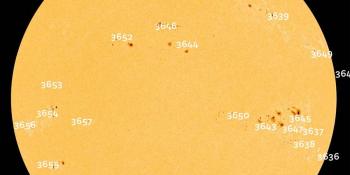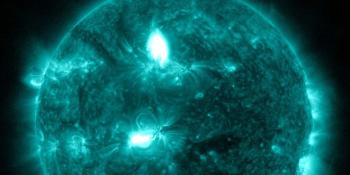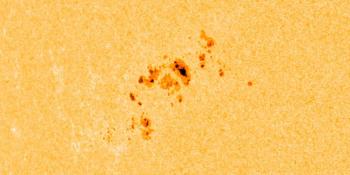Viewing archive of niedziela, 29 października 2000
Raport aktywności słonecznej
Any mentioned solar flare in this report has a scaling factor applied by the Space Weather Prediction Center (SWPC). Because of the SWPC scaling factor, solar flares are reported as 42% smaller than for the science quality data. The scaling factor has been removed from our archived solar flare data to reflect the true physical units.
Raport aktywności słoneczno- geomagnetycznej 2000 Oct 29 2200 UTCPrzygotowane przez NOAA © SWPC i przetworzone przez SpaceWeatherLive.com
Połączenie raportów USAF/NOAA o słonecznej i geofizycznej aktywności
Numer SDF 303 wydany w 2200Z na 29 Oct 2000IA. Analiza aktywności regionów słonecznych i aktywność od 28-2100Z do 29-2100Z Solar activity remained at moderate levels. Region 9209
(S24E21) showed gradual development with an increase in both
penumbral coverage and magnetic complexity. It produced a M4/2B
flare at 29/0157 UTC associated with 1800 sfu Tenflare, Type II and
IV radio sweeps, and a 9-degree filament disappearance. Further
analysis is required to determine if an Earth-directed CME
accompanied this flare. Regions 9212 (N08E61) and 9214 (S11E55)
produced isolated C-class subflares. Both regions showed a slight
degree of magnetic complexity. New Regions 9215 (N20W57) and 9216
(N17W07) were numbered.
IB. Prognoza aktywności słonecznej
Solar activity is expected to be
moderate. Region 9209 is expected to produce isolated M-class
flares. There is also a slight chance for a major flare from this
region.
IIA. Podsumowanie aktywności geofizycznej 28-2100Z do 29-2100Z
Geomagnetic field activity varied from unsettled to minor storm
levels. Minor storm levels were observed until 29/1200 UTC due to
sustained southward IMF Bz. Unsettled to active levels occurred
during the remainder of the period.
IIB. Prognoza aktywności geofizycznej
The geomagnetic field is
expected to be mostly quiet to unsettled during the first day.
Active conditions are possible during the last two days in response
to today's M4 flare.
III. Prawdopodobieństwa zdarzenia 30 Oct do 01 Nov
| Klasa M | 60% | 60% | 60% |
| Klasa X | 10% | 10% | 10% |
| Proton | 10% | 10% | 10% |
| PCAF | green | ||
IV. Przepływ 10,7 cm z Penticton
Zaobserwowano 29 Oct 187 Przewidywane 30 Oct-01 Nov 190/195/200 Średnia z 90 dni 29 Oct 170
V. Indeks geomagnetyczny A
Zaobserwowano Afr/Ap 28 Oct 017/019 Szacowane Afr/Ap 29 Oct 026/028 Przewidywane Afr/Ap 30 Oct-01 Nov 012/018-015/020-012/015
VI. Prawdopodobieństwa aktywności geomagnetycznej 30 Oct do 01 Nov
| A. Średnie szerokości geograficzne | |||
|---|---|---|---|
| Aktywne | 25% | 35% | 25% |
| Słaba burza | 10% | 15% | 10% |
| Bardzo znacząca burza | 05% | 10% | 05% |
| B. Wysokie szerokości geograficzne | |||
|---|---|---|---|
| Aktywne | 25% | 35% | 25% |
| Słaba burza | 10% | 20% | 10% |
| Bardzo znacząca burza | 05% | 15% | 05% |
<< Idź do codziennego przeglądu
Najnowsze wiadomości
Najnowsze wiadomości z forum
AR 3637, 3638, 3643 82Space Weather Memes 338Unproven theories 340Filaments and prominences 55Growth of Cycle 25 433
Więcej tematówWesprzyj SpaceWeatherLive.com!
Wielu ludzi odwiedza SpaceWeatherLive aby śledzić aktywność słoneczną lub sprawdzić czy jest szansa na zaobserwowanie zorzy polarnej. Niestety, większy ruch na stronie oznacza większe koszty utrzymania serwera. Dlatego, jeśli jesteś zadowolony ze strony SpaceWeatherLive, zachęcamy do wspierania nas finansowo. Dzięki temu będziemy mogli utrzymać naszą stronę.

Fakty na temat pogody kosmicznej
| Ostatnie rozbłyski klasy X | 2024/03/28 | X1.1 |
| Ostatnie rozbłyski klasy M | 2024/04/24 | M1.4 |
| Ostatnia burza geomagnetyczna | 2024/04/19 | Kp7 (G3) |
| Spotless days | |
|---|---|
| Ostatni dzień bez skazy | 2022/06/08 |
| Monthly mean Sunspot Number | |
|---|---|
| marca 2024 | 104.9 -19.8 |
| Last 30 days | 129.9 +24.3 |


